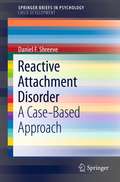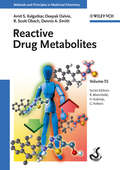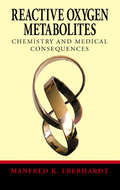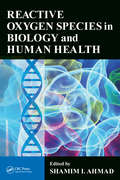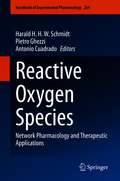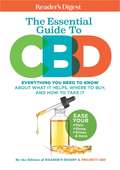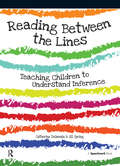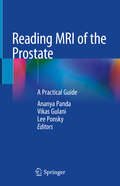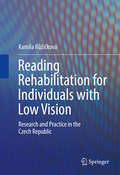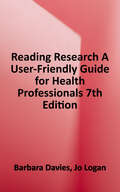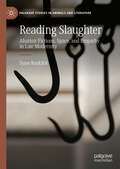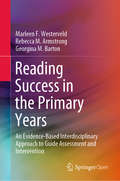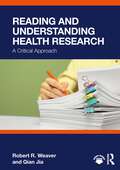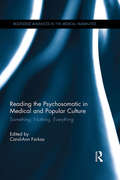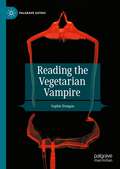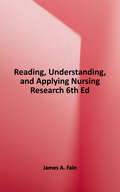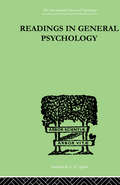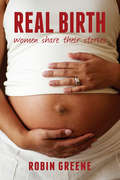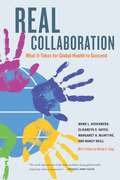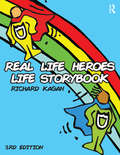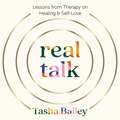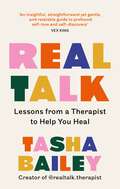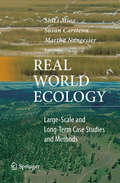- Table View
- List View
Reactive Attachment Disorder
by Daniel F. ShreeveA child's close bond with mother, father, or guardian usually provides a foundation for trust in all future attachments. Children deprived of early and healthy dependency--who do not form normal attachment with their caregivers--may later suffer from Reactive Attachment Disorder (RAD). This childhood disorder is characterized by a general failure in social relationships resulting from pathogenic care. Although first included in the third edition of the Diagnostic and Statistical Manual (DSM-III) in 1980, RAD is one of the more uncommon and understudied forms of psychopathology. Reactive Attachment Disorder: A Case-Based Approach adds to a now growing research base, providing scholars and clinicians with a well-rounded analysis of RAD and suggested treatments. The case-based approach used in this Brief follows the representative case of "Jorge," presented as unfolding over time and structured to illustrate challenges of diagnosis, to show examples of co-morbidity, and to provoke reflection on what questions may arise during treatment. Readers are asked to appraise the overlap with other clinical syndromes, the forms of psychotherapy which may apply, and the potential role of psychiatric medications as part of a comprehensive treatment plan.
Reactive Drug Metabolites
by Raimund Mannhold Gerd Folkers Hugo Kubinyi Douglas A. Smith Deepak Dalvie R. Scott ObachClosing a gap in the scientifi c literature, this first comprehensive introduction to the topic is based on current best practice in one of the largestpharmaceutical companies worldwide. The first chapters trace the development of our understanding of drug metabolite toxicity, covering basic concepts and techniques in the process, while the second part details chemical toxicophores that are prone to reactive metabolite formation. This section also reviews the various drug-metabolizing enzymes that can participate in catalyzing reactive metabolite formation, including a discussion of the structure-toxicity relationships for drugs. Two chapters are dedicated to the currently hot topics of herbal constituents and IADRs.The next part covers current strategies and approaches to evaluate the reactive metabolite potential of new drug candidates, both by predictiveand by bioanalytical methods. There then follows an in-depth analysis of the toxicological potential of the top 200 prescription drugs, illustratingthe power and the limits of the toxicophore concept, backed by numerous case studies. Finally, a risk-benefi t approach to managing the toxicity risk of reactive metabolite-prone drugs is presented.Since the authors carefully develop the knowledge needed, from fundamental considerations to current industry standards, no degree in pharmacology is required to read this book, making it perfect for medicinal chemists without in-depth pharmacology training.
Reactive Oxygen Metabolites: Chemistry and Medical Consequences
by Manfred K. EberhardtIn recent years, the field of radical chemistry has undergone explosive growth. Although its roots lie in organic chemistry, the implications of its findings are having enormous impact in a broad range of disciplines, and we now have evidence for radical involvement in over 100 diseases. As important as this is, however, the subject of radicals and
Reactive Oxygen Species in Biology and Human Health
by Shamim I. AhmadUnlike other narrowly focused books, Reactive Oxygen Species in Biology and Human Health provides a comprehensive overview of ROS. It covers the current status of research and provides pointers to future research goals. Additionally, it authoritatively reviews the impact of reactive oxygen species with respect to various human diseases and discusses antioxidants and other compounds that counteract oxidative stress. Comprised of seven sections, the first section describes the introduction, detection, and production of ROS, emphasizing phenolic compounds and vitamin E for their abilities to act as antioxidants. This section also highlights the role of lipoprotein-associated oxidative stress. Section two addresses the importance of iron accumulation in the brain resulting in the development of a group of neurodegenerative disorders (NDs) and identifies several causative genes for neurodegeneration with brain iron accumulation (NBIA) associated with Parkinsonism-related disorders. The third section discusses a number of NDs, including amyotrophic lateral sclerosis (ALS), Alzheimer’s disease (AD), Huntington's disease (HD), epilepsy, and multiple sclerosis (MS). Section four addresses autoimmune diseases caused by ROS, including asthma, autoimmune liver diseases, rheumatoid arthritis, thyroid disease, primary biliary cirrhosis, and systemic lupus. Section five analyzes a number of different cancers, including lung cancer, breast cancer, and melanoma, along with possible treatment regimens. Section six discusses cardiovascular diseases (CVDs) induced by ROS, presents the ROS-associated complex biochemical processes inducing inflammation as an important cause of CVDs, and explains the roles carotenoids play in preventing CVDs. The final section addresses other human diseases induced by oxidative stress, including sickle cell disease, nonalcoholic steatohepatitis, retinopathy, fibromyalgia, chronic obstructive pulmonary disease, asthma, pulmonary hypertension, infertility, and aging of human skin.
Reactive Oxygen Species: Network Pharmacology and Therapeutic Applications (Handbook of Experimental Pharmacology #264)
by Pietro Ghezzi Harald H. H. W. Schmidt Antonio CuadradoReactive oxygen species (ROS) have been implicated in almost every human disease phenotype, without much, if any, therapeutic consequence foremost exemplified by the failure of the so-called anti-oxidants. This book is a game changer for the field and many clinical areas such as cardiology and neurology. The term ‘oxidative stress’ is abandoned and replaced with a systems medicine and network pharmacology-based mechanistic approach to disease. The ROS-related drugs discussed here target either ROS- forming or ROS -modifying enzymes for which there is strong clinical evidence. In addition, ROS targets are included as they jointly participate in causal mechanisms of disease. This approach is transforming the ROS field and represents a breakthrough in redox medicine indicating a path to patient benefit. In the coming years more targets and drugs may be discovered, but the approach will remain the same and this book will thus become, and for many years remain, the leading reference for ROSopathies and their treatment by network pharmacology. Chapter "Soluble Guanylate Cyclase Stimulators and Activators" is available open access under a Creative Commons Attribution 4.0 International License via link.springer.com.
Reader's Digest The Essential Guide to CBD: What it helps, where to buy it and how to take it
by Reader's Digest and Project CBDThe Reader&’s Digest Essential Guide to CBD is an authoritative but user-friendly primer on CBD.CBD has splashed across the nation&’s headlines, taken the country by storm, and has everyone from Coca-Cola to Starbucks considering adding this new &“miracle supplement&” to their drinks. But the FDA has only approved it for use in treating epilepsy in children. What is CBD, anyway? What&’s the difference between CBD, THC, cannabis, hemp, and marijuana? Can CBD help me lose weight? How much CBD do I need to take to help my condition? What do I look for when buying CBD? Is it better to take CBD oil or gummies or what? The Reader&’s Digest Guide to CBD will answer all of these questions and much more, including both first-person anecdotes of real people&’s experiences with CBD and straightforward reporting about what studies have actually been done and what they show. Written in part by the experts at Project CBD, the book will separate fact from fiction, hype from reality.
Reading Between the Lines: Understanding Inference
by Catherine Delamain Jill SpringSuitable for teachers and speech and language therapists working in the fields of language and literacy, and concerned with developing inferencing skills in their students, this book contains a collection of 300 texts which are graded, and lead the student gradually from simple tasks.
Reading EEGs: A Practical Approach
by James D. Geyer Paul R. Carney John L. GreenfieldFocusing on stepwise development of concepts, pattern recognition and integration with clinical practice, Reading EEGs: A Practical Approach, 2nd Edition, is an easy-to-use, readable guide to learning EEG for neurology residents, clinical neurophysiology fellows, and electroneurodiagnostic students and technologists. The emphasis on waveform recognition enables readers to interpret EEG findings accurately and place them in clinical context. The new landscape format accommodates larger high-quality images for improved study, and the distinctive question-and-answer format is highly effective for review at all levels of training.
Reading MRI of the Prostate: A Practical Guide
by Ananya Panda Vikas Gulani Lee PonskyThis book provides a concise guide to prostate cancer imaging. Beginning with normal MR anatomy, the book details the various components of a typical mpMRI protocol and discusses MR interpretation and reporting under PI-RADS version 2 guidelines. MR appearances of atypical locations of prostate cancer, common tumor mimics, MR-guided biopsy strategies, and the role of active surveillance are also covered. Reading MRI of the Prostate aims to help urologists and radiologists understand the evaluation and interpretation of prostate MRIs.
Reading Rehabilitation for Individuals with Low Vision: Research and Practice in the Czech Republic
by Kamila RůžičkováThis book presents an emerging rehabilitation program for improving the reading abilities of individuals with low vision who undergo therapy for visual impairment. Its interdisciplinary framework for visual training through reading skills development aligns its goals with those of special education programs and features anatomical and psychological background chapters, diverse perspectives on rehabilitation, and empirical supporting data. Program details span theoretical bases, strategies and planning, pedagogical considerations, use of assistive technologies, and assessment of client progress and program efficacy. And by locating rehabilitation in the psychosocial experience of visual disability, the program can be used as a means of building confidence and motivation, contributing to improved quality of life.Included in the coverage:Visual impairment and its impact on development.Rehabilitation of individuals with visual impairment in the Czech Republic.Innovative vision rehabilitation system: theoretical postulates, meanings, and objectives.Reading as a main objective of vision rehabilitation.Verification of effectiveness of the reading performance experimental rehabilitation program.Reading Rehabilitation for Individuals with Low Vision is an essential resource for researchers, clinicians/practitioners, and graduate students in varied fields such as cognitive psychology, rehabilitation, literacy, special education, child and school psychology, visual therapy, and public health.
Reading Research: A User-friendly Guide for Health Professionals
by Barbara Davies Jo LoganLearn how to evaluate and apply health sciences research with this beginner's guide! Reading Research: A User-Friendly Guide for Health Professionals, 7th Edition provides a clear introduction to reading and understanding research articles, with practical guidelines for implementing research into clinical practice. It describes how to interpret common research methods including qualitative, quantitative, and mixed-method approaches, and explains how to find relevant, reliable research on the internet. <P><P>Written by Barbara Davies and Jo Logan, both of whom are noted educators and research experts, this easy-to-use pocket guide is ideal for both students and health professionals.
Reading Slaughter: Abattoir Fictions, Space, and Empathy in Late Modernity (Palgrave Studies in Animals and Literature)
by Sune BorkfeltReading Slaughter: Abattoir Fictions, Space, and Empathy in Late Modernity examines literary depictions of slaughterhouses from the development of the industrial abattoir in the late nineteenth century to today. The book focuses on how increasing and ongoing isolation and concealment of slaughter from the surrounding society affects readings and depictions of slaughter and abattoirs in literature, and on the degree to which depictions of animals being slaughtered creates an avenue for empathic reactions in the reader or the opportunity for reflections on human-animal relations. Through chapters on abattoir fictions in relation to narrative empathy, anthropomorphism, urban spaces, rural spaces, human identities and horror fiction, Sune Borkfelt contributes to debates in literary animal studies, human-animal studies and beyond.
Reading Success in the Primary Years: An Evidence-Based Interdisciplinary Approach to Guide Assessment and Intervention (Springerbriefs In Education Ser.)
by Marleen F. Westerveld Rebecca M. Armstrong Georgina M. BartonThis open access book describes the Reading Success project, in which a 5-step, assessment-to- intervention process, based on the Simple View of Reading, was used within a primary school setting in Australia to better support those students who struggle with reading. It provides an easily accessible overview of each step of the process involved in implementing this approach and highlights the crucial importance of collaboration between professionals involved in the teaching of reading within a school setting. It focuses on the decision-making processes used, such as rich dialogue with the leadership team and teachers, and shares participants’ perspectives gathered throughout the project. Using case studies, the book describes how the 5-step approach assists in creating detailed profiles of students’ strengths and weaknesses in spoken and written language skills that can be used to guide targeted intervention This book offers valuable insights for educators, speech pathologists, researchers, and pre-service teacher education students interested in the teaching of reading
Reading and Understanding Health Research: A Critical Approach
by Robert R. Weaver Qian JiaThis concise guide equips readers with the essential skills required to analyze and critically appraise health research evidence, an integral element to evidence-based practice and professional development.The book offers invaluable guidance by demystifying the structure and language of peer-reviewed research through different stages of reading—inspectional, analytical, and topical—to provide a structured approach to understanding and evaluating research design, methods, and findings. Through analytically reading each section of a research paper, readers can develop a critical appreciation of the evidence, helping them to identify both the strengths and limitations of any piece of research. This critical reading process is a crucial skill, fostering the ability to judiciously apply evidence to health practice, and encouraging a deep engagement with research to better inform health decisions.Ideal reading for students across all health disciplines, whether undergraduate or postgraduate, it will also be a valuable resource for health professionals seeking to enhance their skills in evidence-based practice and continuing professional development. Instructors can also access a range of online resources to support classroom use.
Reading the Psychosomatic in Medical and Popular Culture: Something. Nothing. Everything (Routledge Advances in the Medical Humanities)
by Carol-Ann FarkasPain. Chronic digestive symptoms. Poor sleep. Neuropathy. Sensory disturbances. Fatigue. Panic. Constant illness and discomfort. Frequent difficulty coping with work, school, relationships. Despite the common experience of being told that it’s all in their heads, that they’re just making themselves sick, individuals with these symptoms are experiencing a very real, sometimes debilitating, illness phenomenon. But what is it? Physical or mental illness? Political or social identity? Cultural, narrative, or discursive construction? When something goes awry at the intersection of mind and body – the psychosomatic – what is happening? Widely recognized, yet difficult to classify, diagnose, treat, and explain, psychosomatic disorders are heavily stigmatized, and the associated syndromes have become the site of controversy and antipathy in the provider–patient relationship. In popular culture, terms such as medically unexplained symptoms, hysteria, neurasthenia, hypochondria, functional illness, and malingering are misunderstood, unknown, or rejected outright. Meanwhile, perspectives from cultural and textual studies focus on the psychosomatic as a metaphor in art, literature, and popular media, where disruptions of the body and mind are regularly made to stand in for individual alienation and cultural malaise. Bringing together multiple perspectives, this challenging volume tackles causes, and innovative, humanistic solutions, to conflicts in the provider–patient relationship; uses the psychosomatic as a lens for theorizing the self in culture; and examines the metaphorical potential of the psychosomatic in fictional narrative. Providing a unique assemblage of interdisciplinary, international approaches to understanding the problem of the psychosomatic in both expert and lay discourses, this pioneering edited collection is aimed at students and researchers of health, popular culture, and the health care humanities.
Reading the Vegetarian Vampire (Palgrave Gothic)
by Sophie DunganThis Pivot traces the rise of the so-called “vegetarian” vampire in popular culture and contemporary vampire fiction, while also exploring how the shift in the diet of (some) vampires, from human to animal or synthetic blood, responds to a growing ecological awareness that is rapidly reshaping our understanding of relations with others species. The book introduces the trope of the vegetarian vampire, as well as important critical contexts for its discussion: the Anthropocene, food studies, and the modern practice, politics and ideologies of vegetarianism. Drawing on references to recent historical contexts and developments in the genre more broadly, the book investigates the vegetarian vampire’s relationship to other more violent and monstrous forms of the vampire in popular twenty-first century horror cinema and television. Texts discussed include Interview with the Vampire, Buffy the Vampire Slayer, Twilight, The Vampire Diaries and True Blood. Reading the Vegetarian Vampire examines a new aspect of contemporary interest in considering vampire fiction.
Reading, Understanding, and Applying Nursing Research
by James A. FainWhat is the evidence? How do you find it? How do you evaluate it? Put the evidence to work in your practice! Integrate today's best scientific knowledge into your clinical decision-making. Step by step, you'll learn to effectively evaluate and apply nursing research and to understand its potential impact on the quality of your patient care.
Readings In General Psychology (International Library Of Psychology Ser.)
by Halmos, Paul & Iliffe, AlanThis is Volume XI of thirty-eight of collection of works on General Psychology. Initially published in 1959, with the aim of helping students of psychology, the intention in making this collection of papers is to provide a textbook which instead of the panoramic and superficial presentation of the whole field of psychology we have chosen to show a closer and more detailed view of a limited number of topics in an offering of twelve essays.
Real Birth: Women Share Their Stories
by Robin GreeneIntimate and intensely personal, the forty-five first-person narratives contained in Real Birth: Women Share Their Stories offer readers a window into the complex and emotionally exciting experience of childbirth. Women from a full range of socioeconomic backgrounds and circumstances recount the childbirth choices they've made and the ways those choices have played themselves out in the real life contexts of their everyday lives. Readers meet women from all over the country who speak to us directly--no interviewer intrudes, no judgments intrude, and no single method of childbirth is advocated. Instead, these women offer us their candid experiences, presented clearly and unflinchingly. Medically reviewed by physicians Dr. Richard Randolph for the first edition and Dr. Deborah Morris for this second edition, Real Birth offers readers a plethora of correct information as well the kind of real scoop that other books and health care professionals are often reluctant to reveal. The result is a well-grounded book that reaches across the boundaries of childbirth literature. Real Birth is introduced by Ariel Gore, journalist, editor, writer, and founding editor/publisher of Hip Mama, an Alternative Press Award-winning publication about the culture of motherhood. Also included are an extensive glossary of medical terms, a thoroughly researched selective bibliography, and a list of resources of interest to pregnant women and new moms.
Real Collaboration: What It Takes for Global Health to Succeed
by Mark L. Rosenberg William H. Foege Elisabeth S. Hayes Margaret H. Mcintyre Nancy NeillEssential reading for those who work in global health, this practical handbook focuses on what might be the most important lesson of the last fifty years: that collaboration is the best way to make health resources count for disadvantaged people around the world. Designed as a learning resource to catalyze fresh thinking, Real Collaboration draws from case studies of teams struggling to combat smallpox, river blindness, polio, and other health threats. In honest appraisals, participants share their missteps as well as their successes. Based on these stories, as well as on analyses of many other enterprises, this accessible, engaging book distills the critical factors that can increase the likelihood of success for those who are launching or managing a new partnership. * Features a solutions-oriented approach * Covers leadership skills, management approaches and lessons from experienced project teams * Information is clearly presented in graphics, sidebars, checklists, and other useful features * Supplementary teaching aids including a DVD and additional online resources
Real Life Heroes Life Storybook: A Life Storybook For Children
by Richard KaganReal Life Heroes Life Storybook, 3rd Edition is a resourceful tool for children with traumatic stress. The resiliency-centered format and structure of the volume is coupled with treatment and sessions outlined in the Real Life Heroes Toolkit for Treating Traumatic Stress in Children and Families. This updated edition uses a creative arts approach, encouraging children to work with dependable adults to develop autobiographies through a wide range of activities, including drawings, music, movies, and narrative. By helping children feel protection from adversity and stressors that exist in everyday life, this workbook gives children a sense of value that can promote transformation of troubled children from victims into tomorrow's heroes.
Real Talk: Lessons From Therapy on Healing & Self-Love
by Tasha BaileyIt's time to bring therapy out of the therapy room and into the real world.In recent years, therapy and self-care have become familiar buzzwords, but it's clear that people are having to face their emotional difficulties without the tools and insight to work through them. Enter Real Talk: A book to enable readers to have genuine, authentic conversations with themselves, and to start the journey of healing their past experiences and cope with the challenges of modern life.Filled with techniques and wisdom from a therapist's toolkit this is a must-have handbook for optimising your mental health. Drawing on her experience as a qualified psychotherapist and applying her intersectional perspective Tasha Bailey shares the knowledge and skills you need to change your life.Tasha's straight-talking but compassionate style will help readers hold up a mirror to their present situation and make sense of their past - delving into topics such as:· Trauma & inner-child healing· Love, trust, and attachment· Family: intergenerational cycles of behaviour, rupture, and repair.· Self-Esteem, bodies & sexReal Talk contains a collection of lessons which the reader might typically learn in therapy. Tasha teaches readers modern language and ideas about mental health, exploring self-love and self-understanding. Connecting psychological theory, lived experience, references from modern day media and case studies from Tasha's work to create a more current, creative, and inclusive perspective of mental health.(p) 2023 Octopus Publishing Group
Real Talk: Lessons From Therapy on Healing & Self-Love
by Tasha Bailey'Real Talk is like having a kind, supportive and wise one-to-one with a great therapist.' - Abby RawlinsonIt's time to bring therapy out of the therapy room and into the real world.In recent years, therapy and self-care have become familiar buzzwords, but it's clear that people are having to face their emotional difficulties without the tools and insight to work through them. Enter Real Talk: A book to enable readers to have genuine, authentic conversations with themselves, and to start the journey of healing their past experiences and cope with the challenges of modern life.Filled with techniques and wisdom from a therapist's toolkit this is a must-have handbook for optimising your mental health. Drawing on her experience as a qualified psychotherapist and applying her intersectional perspective Tasha Bailey shares the knowledge and skills you need to change your life.Tasha's straight-talking but compassionate style will help readers hold up a mirror to their present situation and make sense of their past - delving into topics such as:· Trauma & inner-child healing· Love, trust, and attachment· Family: intergenerational cycles of behaviour, rupture, and repair.· Self-Esteem, bodies & sexReal Talk contains a collection of lessons which the reader might typically learn in therapy. Tasha teaches readers modern language and ideas about mental health, exploring self-love and self-understanding. Connecting psychological theory, lived experience, references from modern day media and case studies from Tasha's work to create a more current, creative, and inclusive perspective of mental health.
Real Talk: Lessons From Therapy on Healing & Self-Love
by Tasha Bailey'Real Talk is like having a kind, supportive and wise one-to-one with a great therapist.' - Abby RawlinsonIt's time to bring therapy out of the therapy room and into the real world.In recent years, therapy and self-care have become familiar buzzwords, but it's clear that people are having to face their emotional difficulties without the tools and insight to work through them. Enter Real Talk: A book to enable readers to have genuine, authentic conversations with themselves, and to start the journey of healing their past experiences and cope with the challenges of modern life.Filled with techniques and wisdom from a therapist's toolkit this is a must-have handbook for optimising your mental health. Drawing on her experience as a qualified psychotherapist and applying her intersectional perspective Tasha Bailey shares the knowledge and skills you need to change your life.Tasha's straight-talking but compassionate style will help readers hold up a mirror to their present situation and make sense of their past - delving into topics such as:· Trauma & inner-child healing· Love, trust, and attachment· Family: intergenerational cycles of behaviour, rupture, and repair.· Self-Esteem, bodies & sexReal Talk contains a collection of lessons which the reader might typically learn in therapy. Tasha teaches readers modern language and ideas about mental health, exploring self-love and self-understanding. Connecting psychological theory, lived experience, references from modern day media and case studies from Tasha's work to create a more current, creative, and inclusive perspective of mental health.
Real World Ecology
by Susan Carstenn Martha Nungesser Shili MiaoEcological and environmental research has increased in scope and complexity in the last few decades, from simple systems with a few managed variables to complex ecosystems with many uncontrolled variables. These issues encompass problems that are inadequately addressed using the types of carefully controlled experiments that dominate past ecological research. Contemporary challenges facing ecologists include whole ecosystem responses to planned restoration activities and ecosystem modifications, as well as unplanned catastrophic events such as biological invasions, natural disasters, and global climate changes. Major perturbations implicated in large-scale ecological alterations share important characteristics that challenge traditional experimental design and statistical analyses. These include: * Lack of randomization, replication and independence * Multiple scales of spatial and temporal variability * Complex interactions and system feedbacks. In real world ecology, standard replicated designs are often neither practical nor feasible for large-scale experiments, yet ecologists continue to cling to these same standard designs and related statistical analyses. Case studies that fully elucidate the currently available techniques for conducting large-scale unreplicated analyses are lacking. Real World Ecology: Large-Scale and Long-Term Case Studies and Methods is the first to focus on case studies to demonstrate how ecologists can investigate complex contemporary problems using new and powerful experimental approaches. This collection of case studies showcases innovative experimental designs, analytical options, and interpretation possibilities currently available to theoretical and applied ecologists, practitioners, and biostatisticians. By illustrating how scientists have answered pressing questions about ecosystem restoration, impact and recovery, global warming, conservation, modeling, and biological invasions, this book will broaden the acceptance and application of modern approaches by scientists and encourage further methodological development.
